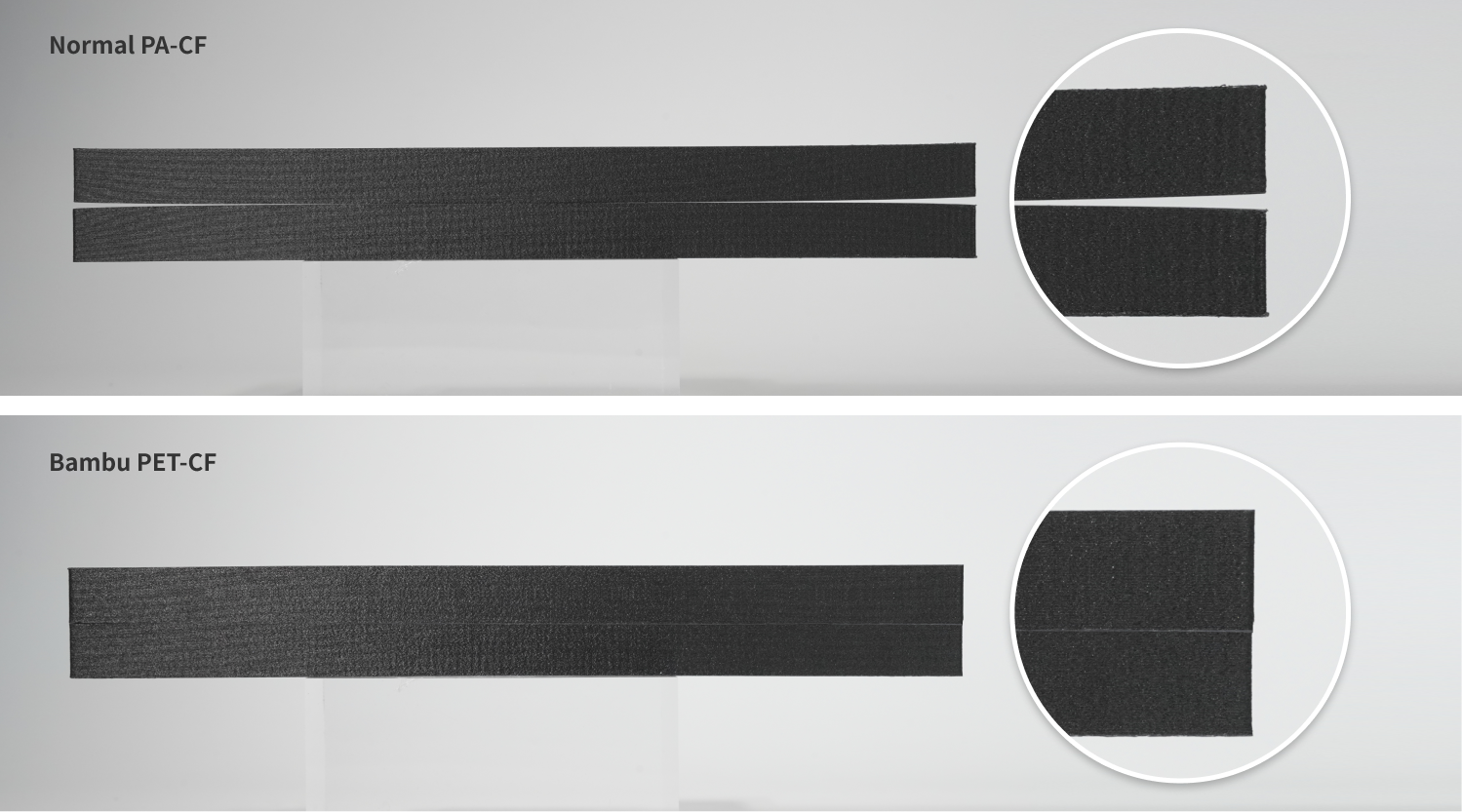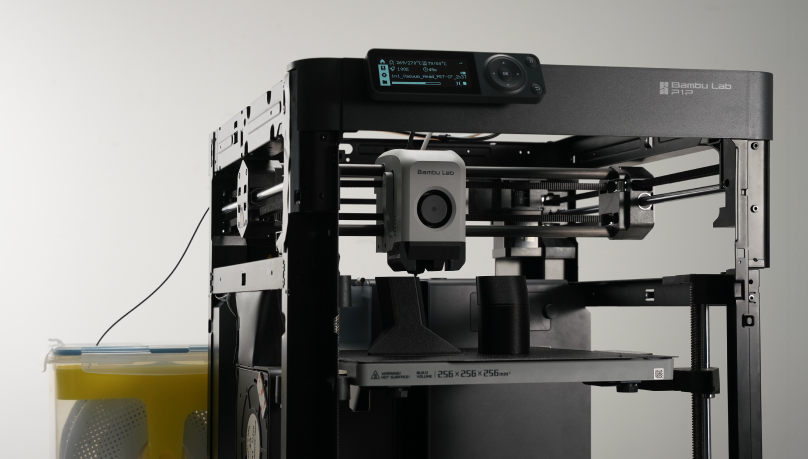Bambu PET-CF
Bambu PET-CF is a blend of tough PET and carbon fiber. Carbon fiber improves hardness and mechanical strength, while still helping maintain the low warping and shrinkage of ordinary PET. Bambu PET-CF has excellent high-temperature resistance and a soft glow appearance. Its excellent strength, heat resistance, dimensional stability, and low moisture absorption make Bambu PET-CF an ideal choice for load-bearing structures or prints used in high-temperature and humid environments.
Low moisture absorption
In saturated water absorption conditions, the strength and stiffness of PET-CF have small losses, making it suitable for prints used in high-humidity environments.
Normal PA-CF
Loading Weight: 1 kg

Bambu PET-CF
Loading Weight: 1 kg

The test models have a span of 220 mm and a thickness of 3 mm in unloaded state.
High dimensional stability
Due to the creep and warping resistance of PET-CF, prints can achieve excellent matching accuracy.

Specimens size (L*W*H): 240*8*15 mm³
Infill density: 60%
Exceptional thermal resistance

Specimen size (L*W*H): 95*10*4 mm³
Test conditions: Specimens were put in an oven at 70 °C and 150 °C respectively for 0.5 hour.
Printing setup
0.6 mm Hardened Steel Nozzle (Recommended)
0.4 mm / 0.8 mm Hardened Steel Nozzle (Capable)
Enclosed printer (Recommended)
Open frame printer (Capable)*
AMS NOT compatible
*Layer bonding of some prints may become low due to overcooling.

Accessory Compatibility
| Recommended | Not Recommended |
| Build Plate | Engineering Plate, High Temperature Plate or Textured PEI Plate | Cool Plate |
| Hotend | Hardened Steel Nozzle(0.4 / 0.6 / 0.8 mm) | Stainless Steel Nozzle (0.2 / 0.4 mm) |
| Glue | Glue Stick | Bambu Liquid Glue |
Frequently Asked Questions
What is the difference between PET-CF and PETG-CF?
The primary difference between PET-CF and PETG-CF lies in their base material. PETG-CF is a reinforced material made by adding carbon fiber to glycol-modified polyethylene terephthalate (PETG), while PET-CF is to polyethylene terephthalate (PET). The key difference 'G' in PETG stands for glycol. PETG is a glycol-modified version of PET that contains small amounts of glycol as a co-monomer. The addition of glycol to PETG reduces its crystallinity and makes it more transparent. However, it also reduces its strength and stiffness.
The difference in application between PETG-CF and PET-CF?
PETG-CF is a versatile basic material that is suitable for printing everyday items, such as bent, folded, and movable parts, due to its excellent toughness and ease of printing. PET-CF, in contrast, contains a greater amount of carbon fiber and is significantly stronger and more temperature resistant compared to PETG-CF. PET-CF is a professional-grade engineering material that is suitable for use in more complex and demanding environments.
What is PET-CF used for?
Due to its dimensional stability and lower water absorption rate, PET-CF is a better choice than nylon for printing functional parts used in high-humidity environments. Also, its high-temperature resistance and low warping make it suitable for printing mechanical assembly parts, such as automotive accessories and fixtures.
| Recommended Printing Settings |
| Drying Settings (Blast Drying Oven) | 80 °C,8 - 12 h |
| Printing and Keeping Container's Humidity | < 20% RH (Sealed, with Desiccant) |
| Nozzle Temperature | 260 - 290 °C |
| Bed Temperature (with PVP Glue) | 80 - 100 °C |
| Printing Speed | < 100 mm/s |
| Physical Properties |
| Density | 1.29 g/cm³ |
| Vicar Softening Temperature | 226 °C |
| Heat Deflection Temperature | 205 °C |
| Melting Temperature | 250 °C |
| Melt Index | 25.3 ± 2.5 g/10 min |
| Mechanical Properties |
| Tensile Strength | 76 ± 5 MPa |
| Breaking Elongation Rate | 4.1 ± 0.5 % |
| Bending Modulus | 5080 ± 210 MPa |
| Bending Strength | 149 ± 4 MPa |
| Impact Strength | 36.0 ± 2.7 kJ/m² |
Download Filament TDS
Download Filament MSDS
Printing Tips
• Bambu PET-CF needs proper drying before printing: recommended drying temperature is 80 ℃ for 5 hours in a blast drying oven, or 90 ℃ for 10 hours on heat bed. (Do not exceed 100 ℃ because the spool may melt). For more details, please refer to:Printing tips for Engineering materials on WIKI.
• To prevent the material from absorbing moisture, it is recommended to use an airtight storage container with desiccant during printing. For more details, please refer to:Printing tips for Engineering materials on WIKI.
What's in the Box

Filament with Spool*1 & Desiccant*1

Filament Label*1

Package*1